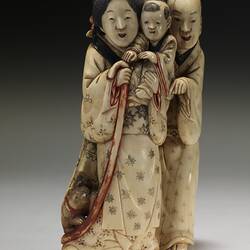Summary
Italian majolica tin-glazed charger depicting an Oriental man on a horse and a woman holding a fan, manufactured in Rome by Torquato Castellani, circa 1878.
Majolica, or maiolica ware is a term traditionally applied to a type of tin-glazed earthenware, popular in Italy during the Renaissance. The term is now more broadly applied to any form of tin-glazed ceramic ware influenced by the original Italian majolica and was considered highly collectable in the late nineteenth century.
The technique developed in the Middle East during the 9th century, befored spreading arcoss the Mediterranean, from Spain into Italy, via the island Majorca, from where the Italian term for this style of ceramic derives.
The earthenware object is first fired at a relatively low temperature before being dipped into a fast-drying glazek, which provides the warm, white background colour onto which the later designs are painted. Once this initial base glaze is dried, the design is painted in tin-based glazes and subsequently fired a second time at a higher temperature, producing the deep, rich colours so typical of this style of ceramic.
Olga and Torquato Castellani were active in the late 19th century. It is claimed they developed modern production techniques. This is shown in the way this charger was manufactured. Created from a mould, the decoration was transfer printed, then over painted by hand. This approach in effect enabled the Castellani workshop to mass produce their work.
Physical Description
Earthenware charger, cream underglaze. The centre painted with an Eastern woman holding a fan in her left hand, and an Eastern man astride a horse, surrounded by flowering plants. The border has a painted decoration of leaves and flowers in green and blue.
More Information
-
Collection Names
-
Collecting Areas
-
Acquisition Information
Cultural Gifts Donation from Dr Will Twycross, 23 Jan 2009
-
Acknowledgement
Donated through the Australian Government's Cultural Gifts Program
-
Manufacturer
-
Place & Date Exhibited
Royal Exhibition Building (REB), Carlton, Greater Melbourne, Victoria, Australia, 1880-1881
-
Collector
Mr John Twycross, Elsternwick, Greater Melbourne, Victoria, Australia, 1881
-
Inscriptions
Hand painted signature on underside: (Intertwined) TC/ Roma Also a sticker added by owners: PRI.? PAINTED PLATE, PERSIAN TYPE/ BY TORQUATO CASTELLANI OF ROME/ (UNIVERSAL EXHIBITION OF 1878)
-
Classification
Royal exhibition building, International exhibitions, Exhibition heritage
-
Category
-
Discipline
-
Type of item
-
Overall Dimensions
410 mm (Width), 50 mm (Height)
-
Maximum dimensions
51 mm (Height), 403 mm (Circumference)
Measurement From Conservation.
-
Keywords
Decorative Arts, Earthenware, Exhibitions: Melbourne International, 1880-1881, Italian Art, Royal Exhibition Building




